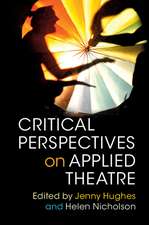Theatre, Performance and Cognition: Languages, Bodies and Ecologies: Performance and Science: Interdisciplinary Dialogues
Editat de Professor Rhonda Blair, Amy Cook Professor John Lutterbie, Prof Nicola Shaughnessyen Limba Engleză Paperback – 23 mar 2016
| Toate formatele și edițiile | Preț | Express |
|---|---|---|
| Paperback (1) | 236.84 lei 43-57 zile | |
| Bloomsbury Publishing – 23 mar 2016 | 236.84 lei 43-57 zile | |
| Hardback (1) | 772.42 lei 43-57 zile | |
| Bloomsbury Publishing – 23 mar 2016 | 772.42 lei 43-57 zile |
Preț: 236.84 lei
Preț vechi: 272.31 lei
-13% Nou
45.32€ • 47.44$ • 37.50£
Carte tipărită la comandă
Livrare economică 07-21 aprilie
Specificații
ISBN-10: 147259178X
Pagini: 256
Ilustrații: 10 bw illus
Dimensiuni: 138 x 216 x 20 mm
Greutate: 0.32 kg
Editura: Bloomsbury Publishing
Colecția Methuen Drama
Seria Performance and Science: Interdisciplinary Dialogues
Locul publicării:London, United Kingdom
Caracteristici
Notă biografică
Rhonda Blair, Professor at Southern Methodist University in Dallas, TX, USA, is the author of The Actor, Image, and Action: Acting and Cognitive Neuroscience (2008), and essays in Theatre Topics, TDR, the Journal of Dramatic Theory and Criticism, among others, and several edited volumes. She was president of the American Society for Theatre Research, 2009-2012. Amy Cook, Associate Professor of Theatre Arts and English at Stony Brook University, New York, USA, is the author of Shakespearean Neuroplay: Reinvigorating the Study of Dramatic Texts and Performance through Cognitive Science, (2010) and essays in, among others, Theatre Journal, TDR, SubStance, the Journal of Dramatic Theory and Criticism, Oxford Handbook of Dance and Theatre, the Oxford Handbook of 4E Cognition (forthcoming). She was the co-chair of the Working Group in Cognitive Science and Performance for American Society for Theatre Research from 2010-2014.
Cuprins
List of Figures List of Contributors AcknowledgementsIntroduction Rhonda Blair and Amy Cook Part 1 Cognitive Linguistics, Theatre and Performance1 Multimodality and Theatre: Material Objects, Bodies and Language, by Barbara Dancygier (The University of British Columbia, Canada) 2 Doth Not Brutus Bootless Kneel? Kneeling, Cognition and Destructive Plasticity in Shakespeare's Julius Caesar, by Laura Seymour (Birkbeck, University of London, UK)3 Performance, Irony and Viewpoint in Language, by Vera Tobin (Case Western Reserve University, USAA Response: The Performing Mind, by Mark Turner (Case Western Reserve University, USA)Part 2 Bodies in Performance4 The Olympic Actor: Improving Actor Training and Performance Through Sports Psychology, by Neal Utterback (Juniata College, USA)5 Becoming Elsewhere: ArtsCross and the (Re)location of Performer Cognition, by Edward C. Warburton (University of California, Santa Cruz, USA)6 Training, Insight and Intuition in Creative Flow, by Christopher J. Jackman (University of Toronto, Canada)A Response: The Body in Mind, by Catherine J. Stevens (University of Western Sydney, Australia)Part 3 Situated Cognition and Dynamic Systems: Cognitive Ecologies7 Distributed Cognition, Mindful Bodies and the Arts of Acting, by Evelyn B. Tribble (University of Otago, New Zealand)8 The Historical Body Map: Cultural Pressures on Embodied Cognition, by Sarah E. McCarroll (Georgia Southern University, USA)9 Another Way of Looking: Reflexive Technologies and HowcThey Change the World, by Matt Hayler (University of Birmingham, UK)A Response: Mapping the Prenoetic Dynamics of Performance, by Shaun Gallagher (University of Memphis, USA, and University of Wollongong, Australia)After Words Appendix: Abstracts of a Few Influential ReferencesNotes ReferencesIndex
Recenzii
There is much in this book to intrigue, inform, and inspire scholars, students, teachers, and practitioners of theatre and performance. Editors Rhonda Blair and Amy Cook provide accessible introductions for those who might be new to the intersection of cognitive science and theatre, while individual chapters advance the knowledge that arises from this confluence by engaging with specific topics in detailed and provocative ways. The chapters are written by authors of diverse provenances, including dance, neuroscience, philosophy, psychology, and narratology, alongside theatre and performance studies. The book also includes helpful appendices in the form of abstracts of influential references that informed the chapter authors' writing, and fascinating "After Words" in which practitioners talk about how their work responds to concepts from cognitive science . The application of cognitive science to theatre and performance studies has become an established theoretical approach. This book advances the field significantly-not just by virtue of the content of the individual chapters, but also by the success of its interdisciplinary format, which stimulates valuable dialogue among its authors.
In their excellent edited collection Rhonda Blair and Amy Cook highlight the evolving and broadening interest in cognitive science (a field that includes neuroscience, psychology, cognitive linguistics, and philosophy) by scholars and practitioners of performance . their book demonstrates how rich and varied this interdisciplinary research has become over the twenty years since it first emerged . one of the strengths of this collection is its demonstration that theatre, dance, and performance studies offer essential insights to the sciences of the mind by analyzing perception, movement, and action in their material, social, and cultural environments.
Appealing to readers from diverse disciplines, the collection is for those beginning to explore the rich terrain of the cognitive humanities.
Descriere
Theatre, Performance and Cognition introduces readers to the key debates, areas of research, and applications of the cognitive sciences to the humanities, and to theatre and performance in particular. It features the most exciting work being done at the intersection of theatre and cognitive science, containing both selected scientific studies that have been influential in the field, each introduced and contextualised by the editors, together with related scholarship from the field of theatre and performance that demonstrates some of the applications of the cognitive sciences to actor training, the rehearsal room and the realm of performance more generally.The three sections consider the principal areas of research and application in this interdisciplinary field, starting with a focus on language and meaning-making in which Shakespeare's work and Tom Stoppard's Arcadia are considered. In the second part which focuses on the body, chapters consider applications for actor and dance training, while the third part focuses on dynamic ecologies, of which the body is a part.



































